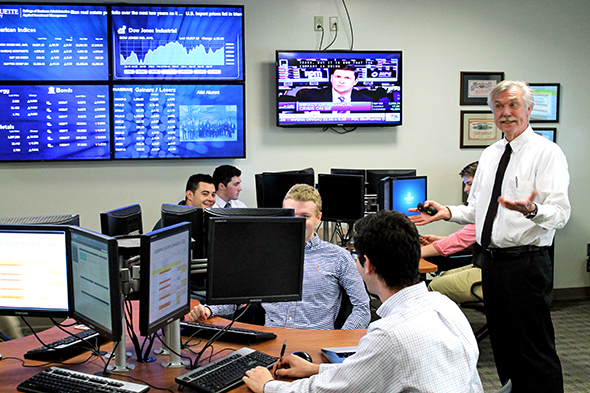Can the monitoring of real-time Twitter feeds be used to identify
trends that lead future stock price movements?
The seniors in the AIM program have begun the spring semester
with a module on behavior finance (see
previous blog). They are learning that emotions can profoundly affect individual
behavior and decision-making. This is different than neo-classical finance theory which suggests that people are rational and always make the best informed decisions.
Can these two competing theories co-exist? Do individuals in a society experience emotions or mood states that affect their collective decision making? Can we tap into the public sentiment and determine in advance emerging trends?
Can these two competing theories co-exist? Do individuals in a society experience emotions or mood states that affect their collective decision making? Can we tap into the public sentiment and determine in advance emerging trends?
Fundamental stock analysts want to know as early as possible what’s "hot" and what isn’t - what products and services are trending positively? What's hot: Apple Watch or Pebble Time; Beats or Skullcandy; Lego Friends or Zoomer Dino; Chipolte or McDonalds; Yoga pants or Levis; Facebook or Instagram; etc.)? Which products are gaining and or losing market share?
 |
| Dr. David Krause, AIM director |
Is this a way to get a jump on future firm success or
weakness? Dr. David Krause, AIM program director, believes so. "We've finally started using Sabermetrics in making better decisions in baseball, why shouldn't we be using advanced metrics in assisting the equity analyst perform fundamental analysis?"
"Data is growing by an amazing rate with the increased use of text messaging, emails, blogs, open source surveys, Facebook, Twitter, etc. The challenge is to access, array and analyze this also overwhelming amount of information - and to use it real-time to make educated investment decisions," according to Krause.
"This week we are going to introduce the AIM students to the use of big data sources and the tools that can be employed in an attempt to understand consumer trends, Krause stated.
"Data is growing by an amazing rate with the increased use of text messaging, emails, blogs, open source surveys, Facebook, Twitter, etc. The challenge is to access, array and analyze this also overwhelming amount of information - and to use it real-time to make educated investment decisions," according to Krause.
"This week we are going to introduce the AIM students to the use of big data sources and the tools that can be employed in an attempt to understand consumer trends, Krause stated.
 |
| Dr. Terence Ow |
 |
| Alex Isken |
Dr. Terence Ow, Associate Professor of Management at Marquette
University and Alex Isken (a member of the AIM Class of 2015) will be presenting the results of
Alex’s Twitter Data and Stock Sentiment Analysis of Tesla to the AIM students next week. A paper that has been submitted recently to an undergraduate research competition.
Previous research has indicated that it is
possible to investigate real-time measurements of collective mood states
derived from large-scale Twitter feeds to predict the sentiment or mood about a
firm’s products or services.
Alex Isken, under Dr. Ow's tutelage, specifically examined whether it was possible to use real-time social media feeds to identify trends that are correlated and lead future stock price movements. This will be new material that has not been presented to the students in the AIM program to this point.
` These students will learn how to extract and array data from Twitter and how to analyze the information to create a company-specific sentiment index. This 'Twitter sentiment' will be analyzed over time to determine whether it can be used to enhance traditional fundamental equity analysis.
These students will learn how to extract and array data from Twitter and how to analyze the information to create a company-specific sentiment index. This 'Twitter sentiment' will be analyzed over time to determine whether it can be used to enhance traditional fundamental equity analysis.
"Determining whether a rising or falling Twitter sentiment trend can serve as a predictor of a company’s future relative stock price is going to be an enhancement to the existing curriculum," according to Dr. Krause. It will be an interesting week.
Alex Isken, under Dr. Ow's tutelage, specifically examined whether it was possible to use real-time social media feeds to identify trends that are correlated and lead future stock price movements. This will be new material that has not been presented to the students in the AIM program to this point.
`
 These students will learn how to extract and array data from Twitter and how to analyze the information to create a company-specific sentiment index. This 'Twitter sentiment' will be analyzed over time to determine whether it can be used to enhance traditional fundamental equity analysis.
These students will learn how to extract and array data from Twitter and how to analyze the information to create a company-specific sentiment index. This 'Twitter sentiment' will be analyzed over time to determine whether it can be used to enhance traditional fundamental equity analysis."Determining whether a rising or falling Twitter sentiment trend can serve as a predictor of a company’s future relative stock price is going to be an enhancement to the existing curriculum," according to Dr. Krause. It will be an interesting week.







